Abstract
The characterization of materials used in the archaeological field needs an experimental approach in order to avoid the destruction or perturbation of artworks. In order to afford this purpose, a multi-analytical spectroscopic approach is regularly used. We combined non-invasive analysis by using handheld spectroscopic instrumentations (mainly XRF and Raman spectrometers) in order to characterize the wall painting preserved in the church of S. Maria delle Palate at Halaesa Arconidea archeological site (Tusa, Messina, Italy). The aim of the work is the characterization of the nature of pigments used for the realization of the wall painting. The wall painting, probably representing St. Francis in the act of receiving the stigmata, has been subject to cleaning and restoration. Thanks to use of in situ measurement, we have identified hematite and goethite for the red and yellow respectively, and lazurite for the blue. In addition, some relevant information about the black pigment, the technique used for the realization and the conservation state were also obtained. The results obtained during the diagnostic campaign have been a support for the work of restorers. For the first time, the wall painting has been studied, increasing the knowledge of Halaesa Arconidea archaeological site.
1. Introduction
The church of S. Maria delle Palate [1] is located on a hill overlooking the coast, in the municipality of Tusa, in the province of Messina (Italy), within the archaeological area of the ancient Halaesa Arconidea [2,3]. The town of Halaesa, on the Tyrrhenian coast of Sicily, was founded in 403 BC and abandoned around the 10th century AD. Halaesa remains famous in history during the establishment of Roman rule and following a probable redistribution of the land, having been one of the first Sicilian cities to come under the rule of the Romans. In 263 BC, the year of the beginning of the first Punic war, the city turned itself in to the invaders, under the consulate of Valerio Massimo and Otacilio Crasso [4]. Today’s Tusa will rise from the ruins of Halaesa, strategically located further inland, on top of a naturally fortified hill. In the middle of the 20th century, the excavations made it possible to trace large tracts of the walls that surrounded the whole hill on which the town was founded.
The original phase of the building complex, where the wall painting is inside, could date back to the Byzantine period. It is mentioned for the first time in a document dated 1123 with the title of Sancta Maria, which later became the Sancta Maria de Palatio (or in the vulgar form S. Maria de li Palazzi). Over time, this toponymy has indicated the entire area in which the ruins of the ancient city are preserved. The structure visible nowadays is the result of rebuilding, on the remains of the Norman church, dated to 1551. Two other successive consolidations occurred between 1734 and 1753, under the bishop Giacomo Bonanno, and in 1978, made by the Genio Civile of Messina. A wall painting, probably representing St. Francis in the act of receiving the stigmata is saved in the church, on the left wall of the unique aisle. The church S. Maria delle Palate and the wall painting are shown in Figure 1.

Figure 1.
(A) Church of S. Maria delle Palate; (B) wall painting of St. Francis.
Considering the peculiarity and the history of this area, we believe that a deeper investigation of this wall painting is necessary in order to improve its purpose. A combination of non-invasive techniques using handheld spectroscopic instrumentations (X-ray Fluorescence-XRF and Raman Spectrometers) was applied in order to characterize the pigments. The characterization of pigments, binding media, etc., and generally the question of ‘colour’ and techniques to obtain them is a large field of investigation in which combined spectroscopies methods are regularly used. In recent years in fact, a combination of non/micro-invasive techniques are frequently used in order to obtain a large number of information about an artwork. As known, the study and characterization of pigments or ligand is a very interesting tool for cultural heritage field operators. The different materials used by artists have a particular chronology and their studies can increase the knowledge about a particular culture or civilization [5]. Moreover, the alteration of pigments in wall paintings can be caused by environmental factors according to their peculiar physical-chemical properties and the environmental conditions in which the artworks are conserved. A detailed analysis of the conservation state is required to understand the processes which are developing on the painted surface [6]. On site measurements are useful to analyse a large area and to define the possible area of collecting [7,8,9,10,11,12,13]. In this case, in relation to the not-movable nature of artworks, the in situ measurements are necessary in order to characterize all different areas without a large number of withdrawals. It is recognized that the best strategy would be the application of portable/hand-held instrumentation, to obtain results in situ and complement them with a limited number of samples [14,15]. In some cases, it is possible or necessary to collect a (micro) sample to confirm or extend the results obtained in situ. In our study, in order to get information about the pigments, some collected samples (only 3) have been analysed by Fourier transform infrared (FT-IR) spectroscopy.
The knowledge of pigments can be a support to define the technique used by the artist and eventual old restoration. In addition, as in this case, this understanding can support the work of the restorers.
2. Instrumentation and Methods
BRAVO handheld Raman spectrometer (Bruker Optik GMBH, Ettlingen, Germany) was used to collect Raman spectra in situ. BRAVO uses a patented technology (SSE™, sequentially shifted excitation, patent number US8570507B1) [16] to mitigate fluorescence phenomena, and it is equipped with two excitation lasers with wavelengths (DuoLaser™) centred at 785 and 853 nm [17]. Lasers work together to mitigate the fluorescence and it is not possible to separate them by means of the experimental setup. The spectra have been collected in the 320–3000 cm1 range with integration times no longer than 60 s.
The identification of Raman signals was made by comparison with a spectral database of reference materials. However, it is important to highlight that, with BRAVO, we cannot register a signal under 320 cm−1 because of the limit of the detector. For this reason, the pigments with Raman bands less than 300 cm−1 (such as cinnabar) cannot be detected.
Tracer III SD AXS instrument (Bruker Optik GMBH, Ettlingen, Germany) with a rhodium anode (voltage 40 kV and current 11 μA) as the source and a Silicon Drift XFlash® as the detector has been used to collected the XRF spectra. Data have been analysed by using the software ARTAX 7. In all acquired spectra, signals related to argon, rhodium and palladium elements were detected. On the one hand, the Ar signal probably appeared due to its presence in the environment, while Rh and Pd signals came from the setup of the used device.
Vertex 70v Fourier transform infrared (FT-IR) spectrometer (Bruker Optik GMBH, Ettlingen, Germany) equipped with a platinum attenuated total reflectance (ATR) module has been used to acquire the attenuated total reflectance (ATR) FT-IR spectra. Spectra were acquired on the collected samples at 2 hPa in the range 4000–140 cm−1, with a resolution of 4 cm−1 and averaging 60 scans. All reflectance spectra have been processed using OPUS 7.5® branded software, the background is automatically corrected [18]. Each spectrum has been compared with a series of absorption spectra of standard reference pigments and binders.
3. Results and Discussion
The investigation by using portable Raman and XRF spectrometers was performed in situ and before the cleaning and restoration interventions. Eighteen areas, representative of all different pigments, were investigated (Figure 2). The Raman and XRF measurements, carried out on the same areas, were planned together with the curator of the archaeological site.
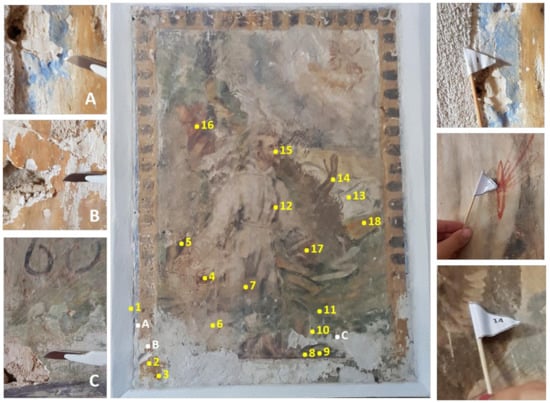
Figure 2.
On-site measurement area (18 points) and points of sampling (A–C).
Raman spectroscopy proved very useful for red, yellow and blue pigments as we show below, while the analysis of the black and brown area didn’t give significant spectra measurements. Even though the same major elements have been identified in all XRF spectra, they presented different relative intensity (Figure 3). In detail, all XRF spectra show the signals of calcium (Ca), iron (Fe), sulfur (S) and strontium (Sr). The calcium is ascribed to the presence of calcite (CaCO3) and/or gypsum (CaSO4·2H2O). The presence of strontium (Sr) in high quantities suggests the presence of the celestite (SrSO4), a mineral usually found to be associated with gypsum. The presence of iron is indicative of pigments of several kinds of iron oxides, ochres that are not expensive and reasonable for this kind of painting. The widespread presence of lead (Pb) in all the analysed areas, in smaller quantities than calcium, is indicative of the presence of white lead (basic lead carbonate (PbCO3)2·Pb (OH)2). The presence of silicon (Si) and potassium (K), characteristic of silicates, may be due to minority components or components of the innermost layer. Based on XRF data, only the above hypothesis can be made. However, some elements present in traces are present in some XRF spectra and, together with the Raman spectra, get light to the palette used by the artist. Here, the more relevant data are presented and discussed, separated for each colour.
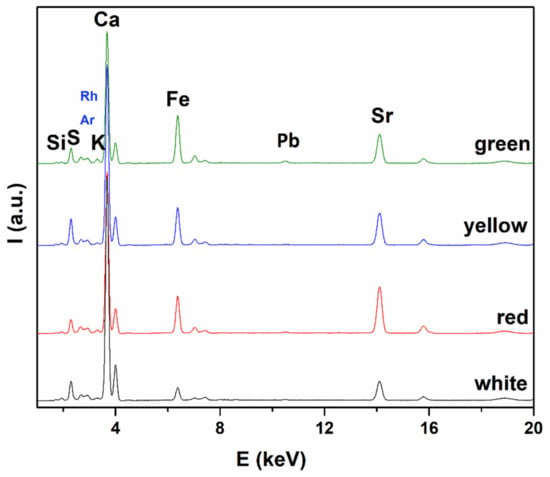
Figure 3.
XRF spectra of some analyzed areas.
Red, Pink and Yellow:
Raman spectra on the red area analysed (in Figure 2; points no. 5, 12 and 17) show bands at 414, 494 and 616 cm−1 (Figure 4A), imputable to hematite (Fe2O3) in addition to gypsum and calcite, and is in agreement with the hypothesis made by XRF. The bands of gypsum (CaSO4·2H2O) are at 597, 670, 1008, 1134, 1620, 3400 and 3530 cm−1, instead calcite (CaCO3) has characteristic bands at 712 and 1086 cm−1, which is in accordance to the literature [19,20]. The pink point shows the same bands of red imputable to hematite, probably used together with a white that was used to tone the coloration. Yellow point (Figure 2; points no. 2 and 3) shows a band at 390 cm−1 attributable to goethite (FeO(OH)), in addition to the band attributable at the bulk and at the hematite pigment (Figure 4B). The presence of white lead (PbCO3)2·Pb(OH)2 is also observed in Raman spectra of red and yellow area showing a band at 1052 cm−1.
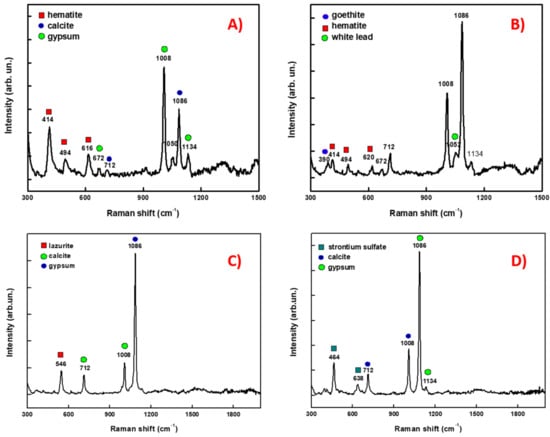
Figure 4.
Raman spectra on (A) red; (B) yellow; (C) blue and (D) white area.
Blue and Green:
Raman spectrum of blue (Figure 2; point no. 1) consists of lazurite pigment (Na3Ca(Al3Si3O12)S) in which it is possible to assign a band at 546 cm−1 (Figure 4C) which is in accordance with data from the literature [21]. In addition, also in this case, lazurite pigments in Raman spectrum are present in the bands of calcite and gypsum.
The IR spectrum acquired from the sample collected on this area shows typical bands at 712, 872, 1412 and 1795 cm−1 associable to calcite, and bands at 597, 670, 1101, 1620, 3400 and 3530 cm−1 imputable to gypsum. In additions, bands imputable to calcium oxalate at 518, 1030 and 1085 cm−1 are probably imputable to biochemical activity of lichens, fungi, algae or bacteria [22]. Moreover, a typical band of C = O stretching mode at 1738 cm−1 is present, as well as two sharp absorption bands attributable to C–H stretching modes at 2916 and 2848 cm−1, attributable to beeswax (see Figure 5B). The presence of beeswax in only one sample suggests a contamination by candles used in the church, as unwanted deposit on the painting [23]. Green pigment doesn’t give a significant Raman spectrum in addition to calcite and gypsum. The presence of iron (Fe) in high quantities in the XRF spectrum suggests the possible presence of the iron oxides (Figure 6A,B).
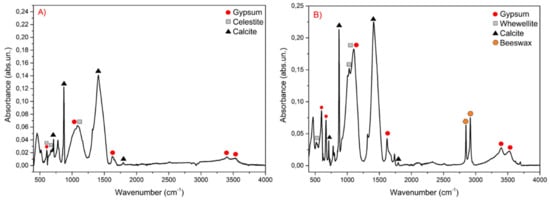
Figure 5.
IR spectra acquired from the collected samples: (A) white, and (B) blue.
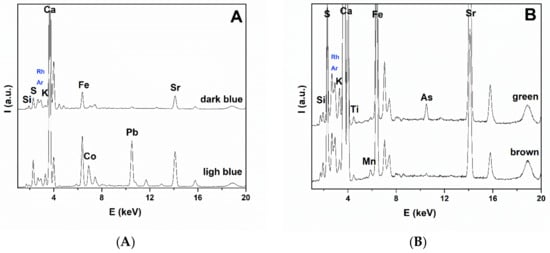
Figure 6.
XRF spectra of (A) blue, (B) green and brown areas.
White:
The Raman spectra on white colour (background and dress of St. Francis) show the same bands of other points; bands at 464 and 638 cm−1 ascribable to strontium sulphate (SrSO4), bands at 712 and 1086 cm−1 imputable to calcite and bands at 1008 and 1134 cm−1 credited to gypsum [24]. The main signals observed in the XRF spectra are calcium (Ca) and strontium (Sr). The IR spectrum acquired on white (Figure 5A) point shows typical bands at 597, 670, 1620, 3400 and 3530 cm−1 imputable to gypsum and bands at 603 and 638 cm−1 associable to celestite. Bands at 712, 872, 1407 and 1795 cm−1 are associable to calcite. In addition, the large band centred at 1085 cm−1, is the result of superimposition of the band at 1131 cm−1 of gypsum and of the bands at 993, 1068 and 1196 cm−1 of celestite. The extensive presence of white lead (basic lead carbonate (PbCO3)2·Pb(OH)2) could be compatible with the technique “a secco”. Below we include some picture in which a deposit of gypsum is visible (Figure 7A) that compromises the reading of the painting and a layer detachment (Figure 7B,C) that is a consequence of pictorial technique. The gypsum is present in the entire pictorial surface and could be due to a sulphation process [25].
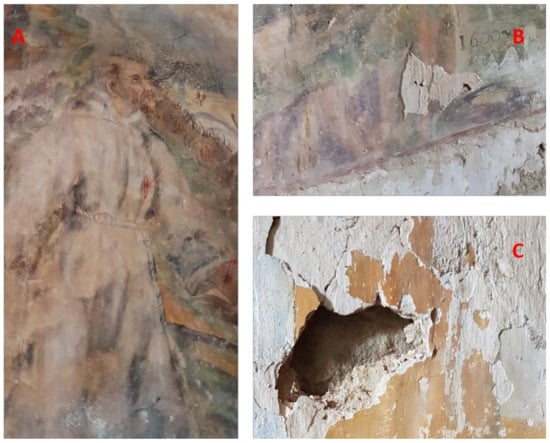
Figure 7.
Details of the wall painting: (A) San Francis; (B) and (C) layer detachments.
Brown, Black and Grey:
Raman spectroscopy did not give significant results for brown and black pigments. In all spectra acquired on these measurement points, we can only identify bulk consistent with other ones. XRF spectra in brown pigments (Figure 6B) show the presence of iron (Fe) and manganese (Mn) indicative of umber (oxide Fe2O3·H2O hydrated iron with manganese dioxide MnO2 and clay silicates like kaolin Al2O3· 2SiO2·2H2O) or burnt umber (anhydrous iron oxide Fe2O3 and manganese dioxide MnO2). The black pigment could be constituted of a black pigment like carbon black, not identifiable by the XRF technique. However, since it was not identified by Raman spectroscopy, it could have a different nature. The greys were obtained by mixing the black pigment with a white to obtain the desired tonality.
4. Conclusions
A combined use of complementary techniques (mainly Raman and XRF spectroscopies) has been applied in situ in order to investigate the pigments of the wall painting preserved in the church of S. Maria delle Palate (Tusa, Messina, Italy). The wall painting is unique in the church of the archaeological site and probably represents St. Francis in the act of receiving the stigmata. The presence of calcite and gypsum is diffused in the whole painting. The gypsum could be due to a sulphation process and an indication of the poorly conserved state of the painting. This result suggests the importance of periodic monitoring of conservation state, which is important for the restorer to be able to define the correct restoration phase. Instead, the presence of white lead could be an indication that the technique used for the realization of the painting was “secco”. The pigments identified are mainly ochres; for the red and yellow (or beige), hematite and goethite were identified, respectively. The nature of black is still unknow. Blue pigment consists of lazurite pigment, instead green is probably based on iron oxide. The white area shows typical bands of calcite, gypsum and celestite usually found associated with gypsum.
In conclusion, this study is a significant contribution to the knowledge of this wall painting which had never been studied before. In addition, the results obtained during the diagnostic campaign provided some details about the conservation state and have been a support with the restoration work, in particular during the phase of cleaning.
Author Contributions
Conceptualization, V.M.N., V.R., S.B., F.P., G.A., E.C., M.L.S., C.S.V., R.C.P.; Archeological data and contexts, G.A., S.B., F.P.; Data curation, V.M.N., V.R., M.L.S.; Formal analysis, V.M.N., V.R., M.L.S.; Investigation, V.M.N., S.B., F.P., G.A., M.L.S., E.C., C.S.V., C.P.; Methodology, E.C., C.S.V., R.C.P.; Project administration, V.M.N., C.S.V., R.C.P.; Supervision, G.A., E.C., C.S.V., R.C.P.; Visualization, V.M.N., V.R., M.L.S., R.C.P.; Writing— original draft, V.M.N., V.R., S.B., F.P., M.L.S., R.C.P.; Writing—review & editing, V.M.N., V.R., S.B., F.P., G.A., E.C., M.L.S., C.S.V., C.P. All authors gave final approval for publication and agree to be held accountable for the work performed therein.
Funding
This work is part of the project “Scienza e tecnologia per il recupero e la fruizione di beni di interesse culturale. —STBIC”— FSE Sicilia 2014/2020 (Programma Operativo del Fondo Sociale Europeo) and the project “Development and Application of Innovative Materials and Processes for the Diagnosis and Restoration of Cultural Heritage—DELIAS”—PON03PE 00214 2 (Programma Operativo Nazionale Ricerca e Competitività2007–2013).
Conflicts of Interest
The authors declare no conflicts of interest.
References
- Scibona, G. Alesa Archonidea: La Chiesa e il Complesso Edilizio Postmedievale; Regione Siciliana, Assessorato dei Beni Culturali e Ambientali e della Pubblica Istruzione, Dipartimento per i Beni Culturali e Ambientali ed Educazione Permanente: Palermo, Italy, 2008; ISBN 9788861640283. [Google Scholar]
- Scibona, G. Alesa Archonidea: Dalla Riscoperta Tardo Rinascimentale Agli Scavi del 20; Regione Siciliana, Assessorato dei Beni Culturali e Ambientali e della Pubblica Istruzione, Dipartimento per i Beni Culturali e Ambientali ed Educazione Permanente: Palermo, Italy, 2008; ISBN 9788861640290. [Google Scholar]
- Barbera, G.; Gullotta, S. The Halaesa landscape (III b.c.) as ancient example of the complex and bio-diverse traditional Mediterranean polycultural landscape. Landsc. Hist. 2014, 35, 53–66. [Google Scholar] [CrossRef]
- Crisà, A. GL Castelli, principe di Torremuzza. LANX 2009, 2, 116–149. [Google Scholar]
- Marcaida, I.; Maguregui, M.; Morillas, H.; Taboada, N.P.; de Vallejuelo, S.F.-O.; Veneranda, M.; Madariaga, J.M.; Martellone, A.; de Nigris, B.; Osanna, M. In situ non-invasive characterization of the composition of Pompeian pigments preserved in their original bowls. Microchem. J. 2018, 139, 458–466. [Google Scholar] [CrossRef]
- Giustetto, R.; Gonella, D.; Diana, E. Decay of red pigments on a wall painting adorning the church of ‘San Francesco Dei Capuccini’ in Racconigi (Italy): Archaeometric survey and restoration intervention. Mediterr. Archaeol. Archaeom. 2018, 5, 65–80. [Google Scholar]
- Saladino, M.L.; Ridolfi, S.; Carocci, I.; Chirco, G.; Caramanna, S.; Caponetti, E. A multi-disciplinary investigation of the “Tavolette fuori posto” of the main hall wooden ceiling of the “Steri” (Palermo, Italy). Microchem. J. 2016, 126, 132–137. [Google Scholar] [CrossRef]
- Saladino, M.L.; Ridolfi, S.; Carocci, I.; Martino, D.C.; Lombardo, R.; Spinella, A.; Traina, G.; Caponetti, E. A multi-analytical non-invasive and micro-invasive approach to canvas oil paintings. General considerations from a specific case. Microchem. J. 2017, 133, 607–613. [Google Scholar] [CrossRef]
- Lauwers, D.; Hutado, A.G.; Tanevska, V.; Moens, L.; Bersani, D.; Vandenabeele, P. Characterisation of a portable Raman spectrometer for in situ analysis of art objects. Spectrochim. Acta Part A 2014, 118, 294–301. [Google Scholar] [CrossRef] [PubMed]
- Armetta, F.; Caponetti, E.; Brusca, L.; Martino, D.C.; Saladino, M.L.; Ridolfi, S.; Chirco, G.; Berrettoni, M.; Conti, P.; Nicolò, B.; et al. A multivariate approach to the study of orichalcum ingots from the underwater Gela’s archaeological site. Microchem. J. 2017, 135, 163–170. [Google Scholar]
- Vandenabeele, P.; Edwards, H.G.M.; Jehlička, J. The role of mobile instrumentation in novel applications of Raman spectroscopy: Archaeometry, geosciences, and forensics. Chem. Soc. Rev. 2016, 43, 2628–2649. [Google Scholar] [CrossRef]
- Vandenabeele, P.; Donais, M.K. Mobile spectroscopic instrumentation in archaeometry research. Appl. Spectrosc. 2016, 70, 27–41. [Google Scholar] [CrossRef]
- Mollica Nardo, V.; Aliotta, F.; Mastelloni, M.A.; Ponterio, R.C.; Saija, F.; Trusso, S.; Vasi, C.S. A spectroscopic approach to the study of organic pigments in the field of Cultural Heritage. Atti della Accademia Peloritana dei Pericolanti 2017, 95, A5. [Google Scholar]
- Marcaida, I.; Maguregui, M.; Morillas, H.; García-Florentino, C.; Knuutinen, U.; Carrero, J.A.; de Vallejuelo, S.F.-O.; Martı, A.P.; Castro, K.; Madariaga, J.M. Multispectroscopic and Isotopic Ratio Analysis to Characterize the Inorganic Binder Used on Pompeian Pink and Purple Lake Pigments. Anal. Chem. 2016, 88, 6395–6402. [Google Scholar] [CrossRef]
- Angeli, L.; Legnaioli, S.; Fabbri, C.; Grifoni, E.; Lorenzetti, G.; Guilaine, J.; Palleschi, V.; Radi, G. Analysis of Serra d’Alto figuline pottery (Matera, Italy): Characterization of the dark decorations using XRF. Microchem. J. 2018, 137, 174–180. [Google Scholar] [CrossRef]
- Conti, C.; Botteon, A.; Bertasa, M.; Colombo, C.; Realini, M.; Sali, D. Portable Sequentially Shifted Excitation Raman spectroscopy as an innovative tool for in situ chemical interrogation of painted surfaces. Analyst 2016, 141, 4599–4607. [Google Scholar] [CrossRef]
- Pozzi, F.; Basso, E.; Rizzo, A.; Cesaratto, A.; Tague, T.J. Evaluation and optimization of the potential of a handheld Raman spectrometer: In situ, noninvasive materials characterization in artworks. J. Raman Spectr. 2019, 50, 861–872. [Google Scholar] [CrossRef]
- Renda, V.; Saladino, M.L.; Caramanna, S.; Chirco, G.; Castello, A.F.; Conti, C.; Marco, A.; Sali, D.; Caponetti, E. Investigation on a low environmental impact solvent mixture applied to a wooden painted slab. IJCS 2016, SP2, 789–796. [Google Scholar]
- Burgio, L.; Clark, R.H. Library of FT-Raman spectra of pigments, minerals, pigment media and varnishes, and supplement to existing library of Raman spectra of pigments with visible excitation. Spectrochim. Acta Part A 2001, 57, 1491–1521. [Google Scholar] [CrossRef]
- Marcaida, I.; Maguregui, M.; Morillas, H.; Taboada, N.P.; Veneranda, M.; de Vallejuelo, S.F.O.; Martellone, A.; de Nigris, B.; Osanna, M.; Madariaga, J.M. In situ non-invasive multianalytical methodology to characterize mosaic tesserae from the House of Gilded Cupids, Pompeii. Herit. Sci. 2019, 7, 3. [Google Scholar] [CrossRef]
- Mollica Nardo, V.; Renda, V.; Anastasio, G.; Caponetti, E.; Saladino, M.L.; Vasi, C.S.; Ponterio, R.C. A combination of portable non-invasive techniques to study on reverse glass paintings at Mistretta museum. Microchem. J. 2019, 146, 640–644. [Google Scholar] [CrossRef]
- Salvadori, B.; Errico, V.; Mauro, M.; Melnik, E.; Dei, L. Evaluation of Gypsum and Calcium Oxalates in Deteriorated Mural Paintings by Quantitative FTIR Spectroscopy. Spectrosc. Lett. 2003, 36, 501–513. [Google Scholar] [CrossRef]
- Baglioni, M.; Poggi, G.; Ciolli, G.; Fratini, E.; Giorgi, R.; Baglioni, P. A Triton X-100-Based Microemulsion for the Removal of Hydrophobic Materials from Works of Art: SAXS Characterization and Application. Materials 2018, 11, 1144. [Google Scholar] [CrossRef]
- Buzgar, N.; Buzatu, A.; Sanislav, I.V. The Raman study on certain sulfates. Analele Stiintifice ale Universitatii Al. I. Cuza 2009, 55, 5–23. [Google Scholar]
- Ferroni, E.; Malaguzzi Valerj, V.; Rovida, G. Experimental Study by Diffraction of Heterogeneous Systems as a Preliminary to the Proposal of a Technique for the Restoration of Gypsum Polluted Murals. In Proceedings of the ICOM Conference, Amsterdam, The Netherlands, September 1969. [Google Scholar]
© 2019 by the authors. Licensee MDPI, Basel, Switzerland. This article is an open access article distributed under the terms and conditions of the Creative Commons Attribution (CC BY) license (http://creativecommons.org/licenses/by/4.0/).